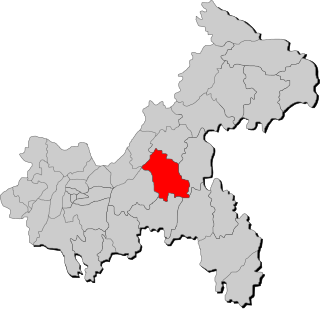
The Tiananmen, or the Gate of Heavenly Peace, is a monumental gate in the centre of Beijing, widely used as a national symbol of China. First built during the Ming dynasty in 1420, Tiananmen was the entrance to the Imperial City, within which the Forbidden City was located. Tiananmen is located to the north of Tiananmen Square, separated from the plaza by Chang'an Avenue.

Heping District is a district in the center of Tianjin, China.

Pinggu District, formerly Pinggu County (平谷县), lies in the far east of Beijing Municipality. It has an area of 950 square kilometres (370 sq mi) and a population of 396,701. The district is subdivided into 2 subdistricts, 14 towns, and 2 townships. It borders the Beijing districts of Miyun and Shunyi to the north and west, respectively, Tianjin's Jizhou District to the southeast, and in Hebei province, Xinglong County and Sanhe to the northeast and south, respectively.

Beijing Normal University, colloquially known as 北师大 or Beishida, is a public research university located in Beijing, China, with a strong emphasis on basic disciplines of the humanities and sciences. It is one of the oldest and most prestigious universities in China, and was recognized by the Chinese Ministry of Education as a Class A Double First Class University.
The Treaty of Peace and Friendship between Japan and the People's Republic of China is a peace treaty concluded between the People's Republic of China and Japan on August 12, 1978. The treaty was signed in Beijing by Huang Hua, Foreign Minister of the People's Republic of China, and Sunao Sonoda, Minister for Foreign Affairs of Japan. The treaty went into effect on October 23, 1978 with the state visit of Vice Premier of the PRC Deng Xiaoping to Japan. The treaty had its origin in the Joint Communiqué of the Government of Japan and the Government of the People's Republic of China of 1972. Negotiations on a formal peace treaty began in 1974, but were drawn out over various disputes until 1978. The treaty ultimately consisted of five articles, and was strongly opposed by the Soviet Union.

Hepingli is a residential neighborhood and a subdistrict of Dongcheng District, Beijing. It is situated in the northeastern part of the city between the northern 2nd Ring Road and the northern 3rd Ring Road. The neighborhood is bordered by Andingmen Waidajie to the west and Hepingli Dongjie to the east. Most of the neighborhood is located in Chaoyang District. Its southern fringe around the Temple of Earth is in Dongcheng District.
The Gate of China, is a gate and defensive complex on the city wall of Nanjing, China. It is the southern gate of Nanjing city. It is a renowned ancient city gate in China and the city gate with the most complex structure in the world.

Fengdu County is a county located in Chongqing Municipality, People's Republic of China. The county was established as Fengdu County (豐都縣) during the Sui Dynasty. The name was changed to Fengdu County (酆都縣) during the Ming Dynasty. In 1958, the name was changed back to Fengdu County (豐都縣).
The Roman Catholic Diocese of Yongping/Lulong is a Latin diocese in the Ecclesiastical province of Beijing in PR China, without canonically mandated Ordinary since decades.

Hepingmen Station is a station on Line 2 of the Beijing Subway.

Hepingxiqiao Station is a station on Line 5 of the Beijing Subway.

Hepingli Beijie Station is a station on Line 5 of the Beijing Subway.

Wanping Fortress, also known as Wanping Castle, is a Ming Dynasty fortress or "walled city" in Beijing. It was erected in 1638–1640, with the purpose of defending Beijing against Li Zicheng and the peasant uprising.

Luanping County is a county of northeastern Hebei province, with the Great Wall demarcating its border with Miyun County, Beijing to the southwest. It is under the administration of Chengde City, and has a population of 340,000 residing in an area of 3,195 km2 (1,234 sq mi). The G45 Daqing–Guangzhou Expressway, China National Highways 101 and 112, and the Beijing–Tongliao Railway pass through the county. Other bordering county-level divisions are Fengning County to the northwest, Longhua County to the north, Chengde's core districts of Shuangqiao and Shuangluan to the east, and Chengde County to the southeast.
Beijing has many neighborhoods, some of which are new and others with a long history.

Rong Bao Zhai is an old stationery, calligraphy and painting shop in Beijing, China. It is located in Liulichang outside the Hepingmen Gate. It was founded in 1672 as the Song Zhu Zhai, and adopted its current name in 1894.














